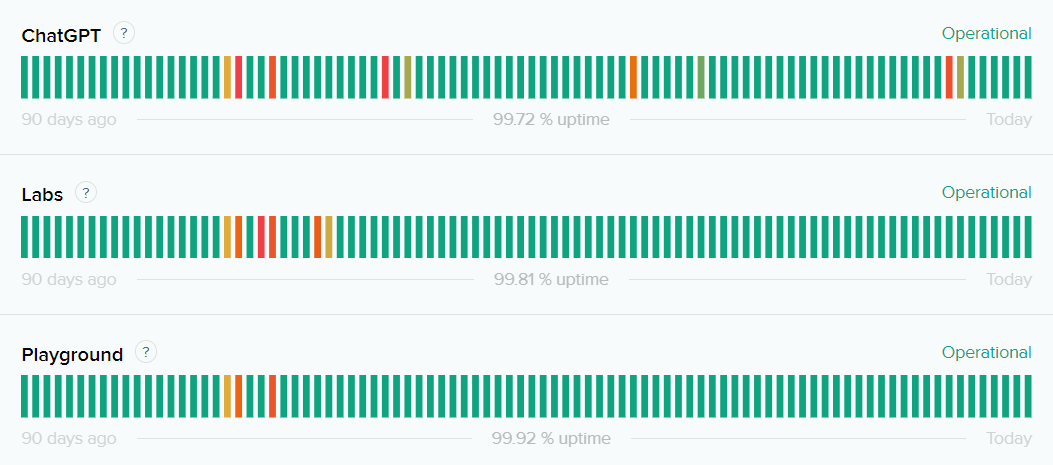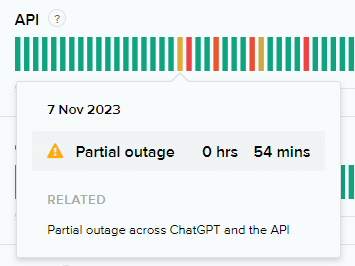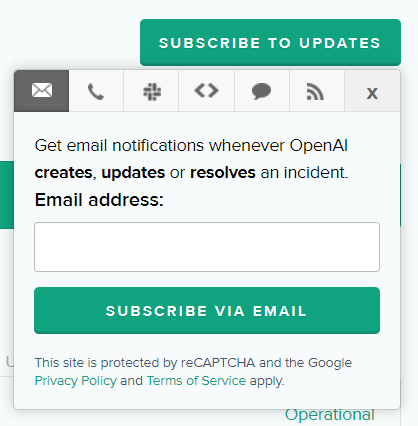In the field of AI technology, the smoothness of APIs, like those from OpenAI is important. Frequent downtimes or performance issues can disrupt various services, both small and large. Understanding the status of these APIs is not just a technical skill, it’s essential for project success.
This guide focuses on the OpenAI API status page. We’ll show you how to read the status indicators and their impact on your work. For example, the 99.74% uptime statistic in the last 90 days ago of API status signifies a dependable service.
With this information, you can make better decisions, whether you’re integrating an API into your project or troubleshooting an issue. Let’s explore these details and learn what statuses mean.
Table of Contents
What is OpenAI status?
OpenAI status is a real-time monitoring tool that gives updates on the operational condition of OpenAI’s services, including its APIs. It’s a dashboard that shows the current status of these services, whether they are working, having problems, or under maintenance.
The status is vital for users and developers who depend on OpenAI’s technologies, providing instant insights into any disruptions or performance issues.
OpenAI API status
The OpenAI API status section is crucial if you want to integrate OpenAI’s APIs into your applications and systems.

It provides information about the availability and performance of APIs like ChatGPT, DALL·E, Whisper, and more. Knowing the status of these APIs assists you in planning, and ensuring the smooth operation of applications relying on OpenAI’s technology.
Other OpenAI status
In addition to the API status, OpenAI also provides updates on other essential components of their ecosystem. These include ChatGPT, Labs, and Playground, each of which plays a significant role in the OpenAI suite. These status updates are valuable for you if you are using these services.

ChatGPT
ChatGPT is OpenAI’s conversational AI model, widely utilized in various applications, ranging from customer service to creative writing. You can monitor ChatGPT’s status to detect issues with interactive communication tasks, such as errors in chatbots or automated responses.
Labs
OpenAI Labs is the experimental branch where new features and models are developed and tested. Keeping an eye on the Labs status is important if you’re experimenting with the latest AI technologies because disruptions here can impact research, development, and testing of new AI applications.
Playground
The Playground is a user-friendly interface that allows direct interaction with OpenAI’s models, enabling testing and experimentation with their capabilities. The Playground’s status is particularly relevant for educators, researchers, or if you want to explore AI power without coding. Issues in the Playground can affect prototyping, learning, and experimenting with AI models.
Status indicators
When visiting the OpenAI status page, it’s simple to grasp the meaning of the color-coded status indicators. Here’s a guide to what each color means:
Green
Status: Operational.
A green indicator is great news. It means the API is fully operational, running smoothly, with no known issues affecting the service.

If you’re using or planning to use OpenAI’s APIs, a green status gives you confidence to proceed without expecting service interruptions.
Yellow
Status: Partial outage or degraded performance.
Yellow is a heads-up. It means the API is functional but not performing at its best. This could result in slower response times or some features working less efficiently than usual.

If you encounter a yellow status, be prepared for potential delays or minor issues. It’s usually not a deal-breaker but may affect your efficiency.
Red
Status: Major outage or partial outage.
Red is a warning sign. It indicates a significant problem – either a complete service outage or severe limitations.

With a red status, it’s best to postpone critical tasks relying on the API until the issue is resolved. Keep an eye on updates to know when the service returns to normal.
Note: These statuses are real-time updates, so it's good practice to check them regularly, especially if you heavily depend on OpenAI's technologies.
Recent incidents and updates
OpenAI’s services like any advanced tech, can encounter problems. So, you should stay informed about recent incidents and updates on their services.
In the past few days, OpenAI’s status page has reported a few incidents:
- API Latency issues (January 16, 2024): Users experienced delays in response times. OpenAI’s team swiftly identified and resolved the problem, minimizing the impact.
- GPT-3.5-Turbo performance drop (January 14, 2024): Some specific models showed a decline in performance. The issue was promptly addressed, highlighting OpenAI’s commitment to maintaining high service standards.
Do not worry! OpenAI’s approach to handling these issues has been transparent and efficient. Each incident was communicated clearly, with regular updates provided.
Uptime history
The Uptime history page provides a detailed look at the service’s reliability over time. It’s a valuable tool for evaluating the stability of OpenAI’s APIs.
Visit the page here: https://status.openai.com/uptime

Uptime metrics are essential. For example, a 100% uptime percentage in January 2024 indicates smooth and reliable service, which is crucial for planning and operational confidence. These metrics demonstrate the strength of OpenAI’s infrastructure.
Subscribe to updates
The SUBSCRIBE TO UPDATES feature on OpenAI’s status page is a simple way to stay informed. You can sign up to receive real-time notifications about the status of services to ensure you’re always on the latest.

These updates are especially helpful during incidents. They allow you to quickly adjust your workflows, minimizing potential disruptions caused by unexpected service issues.
Practical implications
For developers and businesses, the status information serves as more than just updates; it’s a tool for risk management and strategic planning. Likewise, for users, this information is valuable for creating effective plans and scheduling maintenance or updates during low-impact periods.
Being aware of the current service status will assist you in making informed decisions for your projects.
Final thoughts
Understanding the OpenAI status is important when using OpenAI’s API services, as downtime can affect everything from small projects to large operations. Therefore, regularly checking the OpenAI status is key for effective planning and problem-solving.

